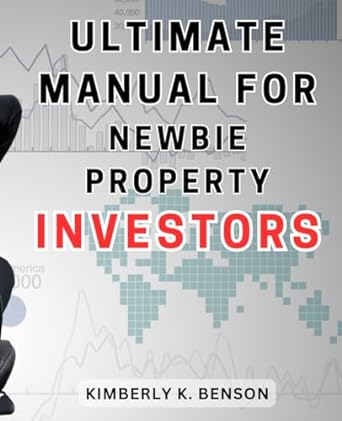Mercury Athletic Footwear: Valuing the Opportunity
2) Why might WCF be considering divesting MAF (offer at least 6 reasons, 12 points total, 2 points each)?
3) What are the likely pros and cons associated with AGIs potential acquisition of MAF (offer at least 12 total pros and cons, 24 points total, 2 points each)?
4) Make a recommendation to AGIs board of directors to either continue pursuing the acquisition or pass on the opportunity. Include a recommended price range which is attractive to your group. (9 points total, citing at least three key factors influencing your recommendation, 3 points each)?
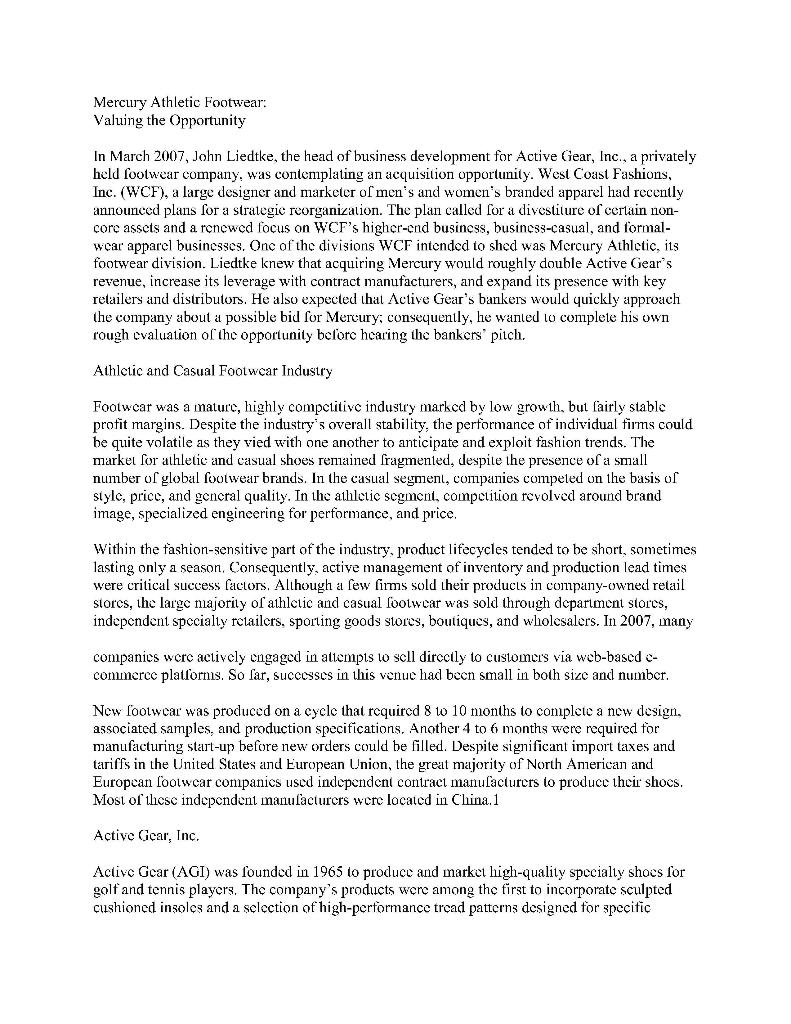
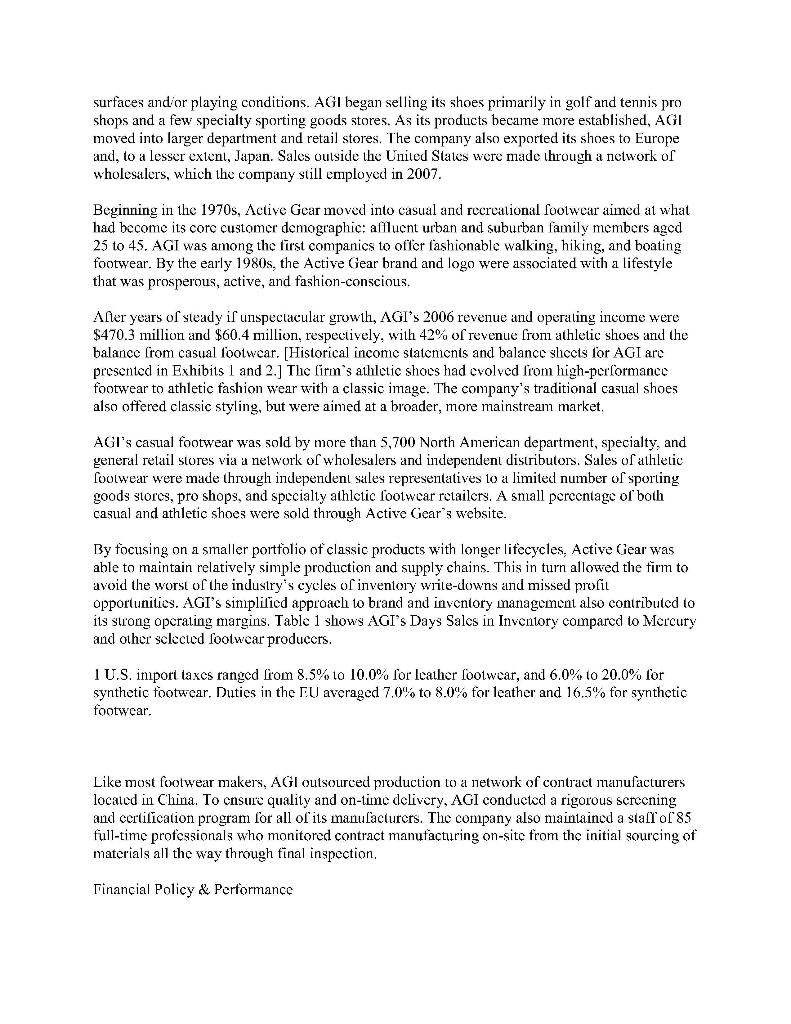
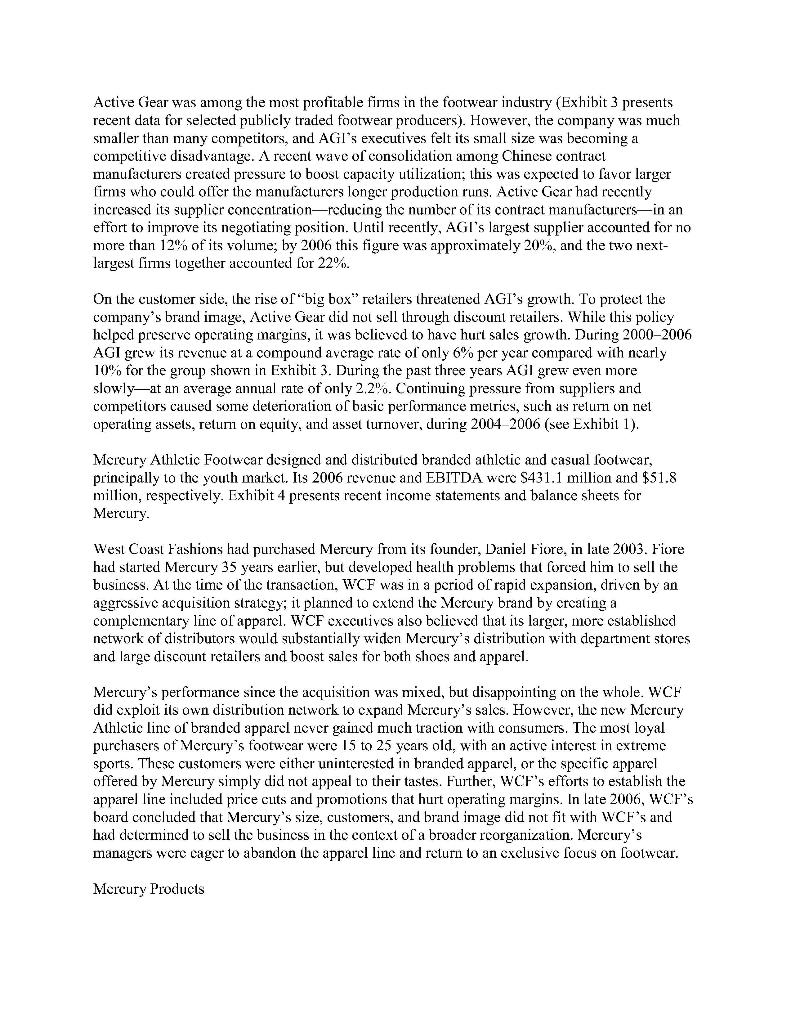
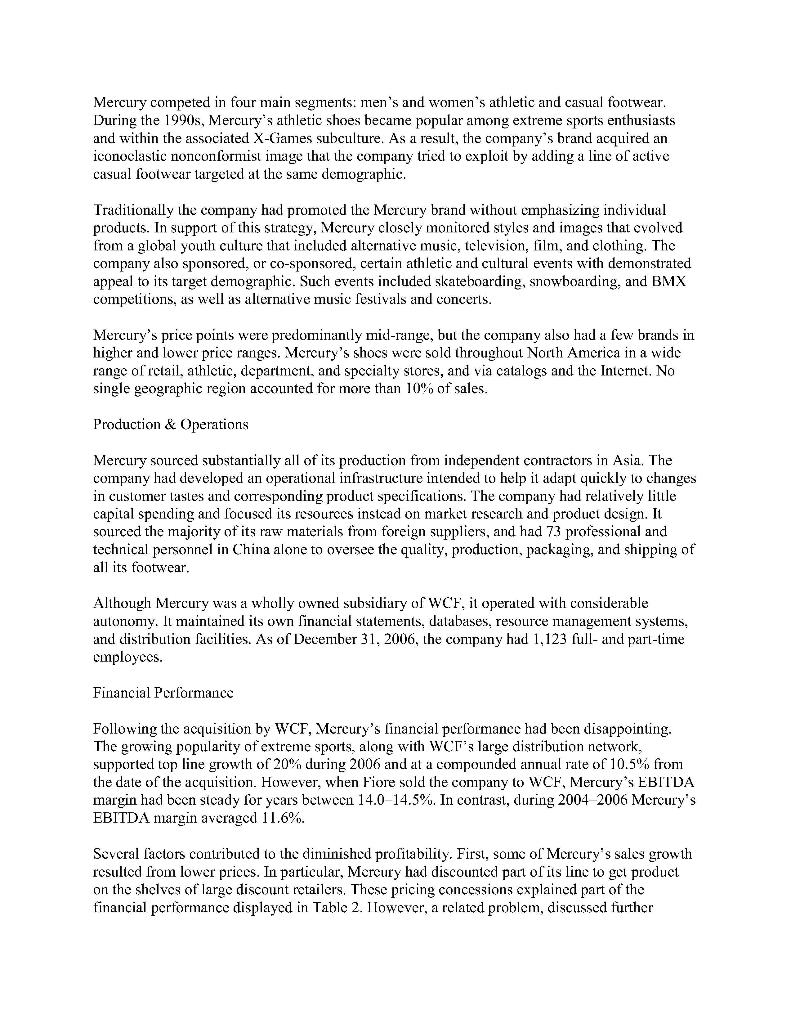
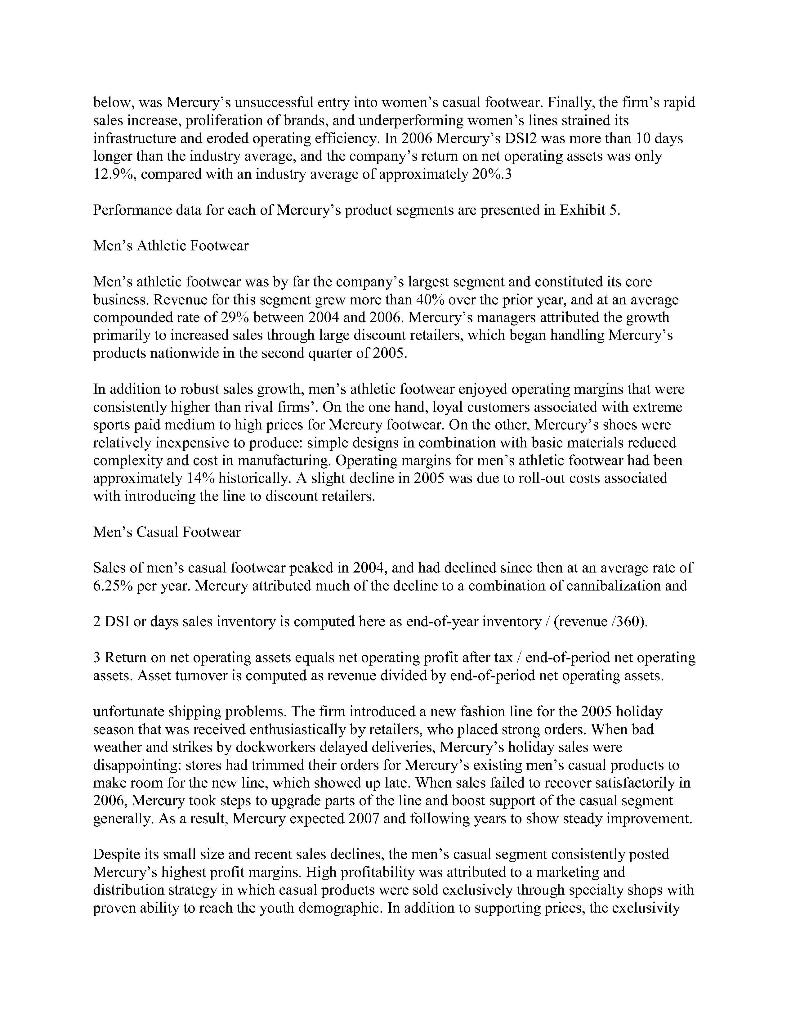

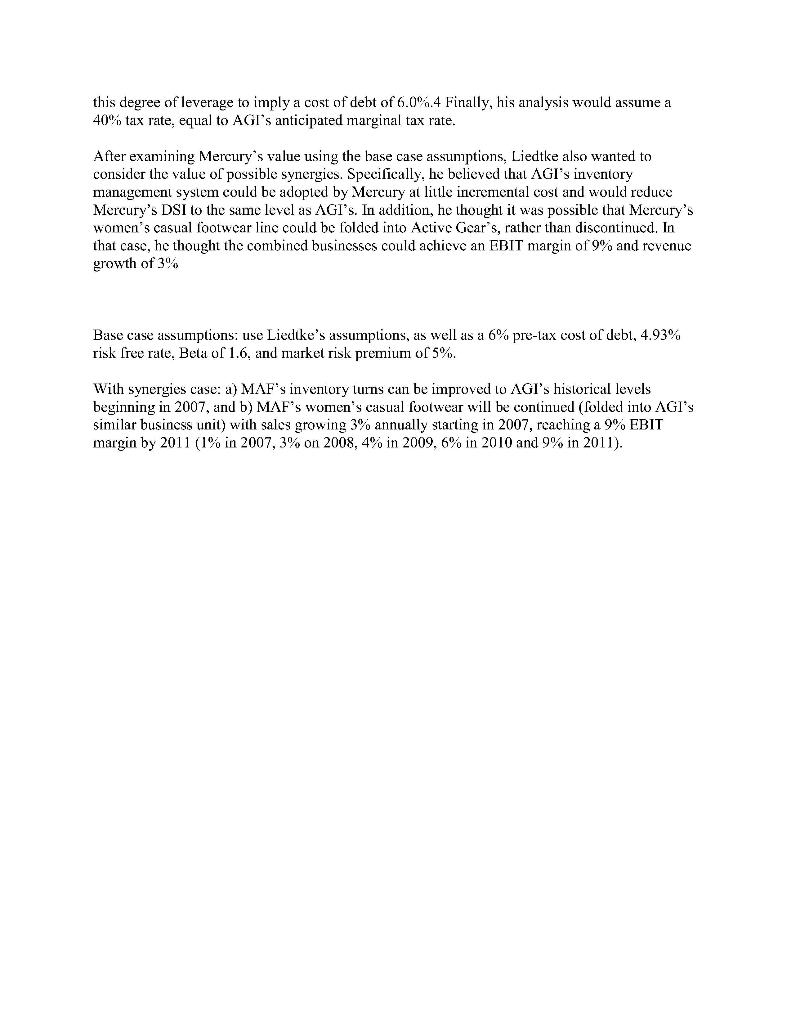
Mercury Athletic Footwear: Valuing the Opportunity In March 2007, John Liedtke, the head of business development for Active Gear, Inc., a privately held footwear company, was contemplating an acquisition opportunity. West Coast Fashions, Inc. (WCF), a large designer and marketer of men's and women's branded apparel had recently announced plans for a strategic reorganization. The plan called for a divestiture of certain non- core assets and a renewed focus on WCF's higher-end business, business-casual, and formal- wear apparel businesses. Onc of the divisions WCF intended to shed was Mercury Athletic, its footwear division. Liedtke knew that acquiring Mercury would roughly double Active Gear's revenue, increase its leverage with contract manufacturers, and expand its presence with key retailers and distributors. He also expected that Active Gear's bankers would quickly approach the company about a possible bid for Mercury, consequently, he wanted to complete his own rough evaluation of the opportunity before hcaring the bankers pitch. Athletic and Casual Footwear Industry Footwear was a mature, highly competitive industry marked by low growth, but fairly stable profit margins. Despite the industry's overall stability, the performance of individual firms could be quite volatile as they vied with one another to anticipate and exploit fashion trends. The market for athletic and casual shoes remained fragmented, despite the presence of a small number of global footwear brands. In the casual segment, companies competed on the basis of style, price, and general quality. In the athletic segment, competition revolved around brand image, specialized engineering for performance, and price. Within the fashion-sensitive part of the industry, product lifecycles tended to be short, sometimes lasting only a season. Consequently, active management of inventory and production lead times were critical success factors. Although a few firms sold their products in company-owned retail stores, the large majority of athletic and casual footwear was sold through department stores, independent specially retailers, sporing goods stores, boutiques, and wholesalers. In 2007, many companies were actively cngaged in attempts to sell directly to customers via web-based c- commerce platforms. So far, successes in this venue had been small in both size and number. New footwear was produced on a cycle that required 8 10 10 months to complete a new design. associated samples, and production specifications. Another 4 to 6 months were required for manufacturing start-up before new orders could be filled. Despite significant import taxes and tariffs in the United States and European Union, the great majority of North American and European footwear companics used independent contract manufacturers to produce their shocs. Most of these independent manufacturers were located in China. 1 Active Gear, Inc. Active Gear (AGI) was founded in 1965 to produce and market high-quality specially shocs for golf and tennis players. The company's products were among the first to incorporate sculpted cushioned insoles and a selection of high-performance trcad patterns designed for specific surfaces and or playing conditions. AGI began selling its shoes primarily in golf and tennis pro shops and a few specialty sporting goods stores. As its products became more established, AGI moved into larger department and retail stores. The company also exported its shoes to Europe and, to a lesser extent, Japan. Sales outside the United States were made through a network of wholesalers, which the company still employed in 2007. Beginning in the 1970s, Active Gear moved into casual and recreational footwear aimed at what had become its core customer demographic: aflluent urban and suburban family members aged 25 to 45. AGI was among the first companies to offer fashionable walking, hiking, and boating footwear. By the early 1980s, the Active Gear brand and logo were associated with a lifestyle that was prosperous, active, and fashion-conscious. After years of steady if unspectacular growth, AGI's 2006 revenue and operating income were $470.3 million and $60.4 million, respectively, with 42% of revenue fron athletic shoes and the balance from casual footwear, [Historical income statements and balance sheets for AGI arc presented in Exhibits 1 and 2.] The lirm's athletic shocs had evolved from high-performance footwear to athletic fashion wear with a classic image. The company's traditional casual shoes also offered classic styling, but were aimed at a broader, more mainstream market, AGI's casual footwear was sold by more than 5,700 North American department, specialty, and general retail stores via a network of wholesalers and independent distributors. Sales of athletic footwear were made through independent sales representatives to a limited number of sporting goods stores, pro shops, and specialty athletic footwcar retailers. A small percentage of both casual and athletic shoes were sold through Active Gear's website. By focusing on a smaller portfolio of classic products with longer lifecycles, Active Gear was able to maintain relatively simple production and supply chains. This in turn allowed the firm to avoid the worst of the industry's cycles of inventory wile-downs and missed profil opportunities. AGI's simplificd approach to brand and inventory management also contributed to its strong operating margins. Table 1 shows AGI's Days Salcs in Inventory compared to Mercury and other sclected footwear producers. 1 U.S. import taxes ranged from 8.5 10 10.0% for Icather footwear, and 6.0% 10 20.0% for synthetic footwear. Duties in the EU averaged 7.0% to 8.0% for leather and 16.5% for synthetic footwear Like most footwear makers, AGI outsourced production to a network of contract manufacturers located in China. To ensure quality and on-time delivery, AGI conducted a rigorous sereening and certification program for all of its manufacturers. The company also maintained a stall of 85 full-time professionals who monitored contract manufacturing on-site from the initial sourcing of materials all the way through final inspection, Tinancial Policy & Performance Active Gear was among the most profitable firms in the footwear industry (Exhibit 3 presents recent data for selected publicly traded footwear producers). However, the company was much smaller than many competitors, and AGI's executives felt small size was becoming a competitive disadvantage. A recent wave of consolidation among Chinese contract manufacturers created pressure to boost capacity utilization, this was expected to favor larger firms who could offer the manufacturers longer production runs. Active Gear had recently increased its supplier concentration-reducing the number of its contract manufacturers-in an effort to improve its negotiating position. Until recently, AGI's largest supplier accounted for no more than 12% of its volume; by 2006 this figure was approximately 20%, and the two next- largest ims together accounted for 22%. On the customer side, the rise of "big box retailers threatened AGI's growth. To protect the company's brand image, Active Gear did not sell through discount retailers. While this policy helped preserve operating margins, it was bclicved to have hurt sales growth. During 2000-2006 AGI grew its revenue at a compound average rate of only 6% per ycar compared with ncarly 10% for the group shown in Exhibit 3. During the past three years AGI grew even more slowlyat an average annual rate of only 2.2. Continuing pressure from suppliers and competitors caused some deterioration of basic performance metrics, such as reluin on net operating assets, retuni on equity, and asset turnover, during 2004-2006 (see Exhibit 1). Mercury Athletic Footwear designed and distributed branded athletic and casual lootwear, principally to the youth markct. Its 2006 revenue and EBITDA were $431.1 million and $51.8 million, respectively. Exhibit 4 presents recent income statements and balance sheets for Mercury. West Coast Fashions had purchased Mercury from its founder, Daniel Fiore, in late 2003. Fiore had started Mercury 35 years earlier, but developed health problenis that forced him to sell the business. At the time of the transaction, WCF was in a period of rapid expansion, driven by an aggressive acquisition strategy; it planned to extend the Mercury brand by crcaling a complementary line of apparel. WCF cxccutives also bclicved that its larger, more established network of distributors would substantially widen Mercury's distribution with department stores and large discount retailers and boost sales for both shoes and apparel. Mercury's performance since the acquisition was mixed, but disappointing on the whole. WCF did exploit its own distribution network 10 expand Mercury's sales. However, the new Mercury Athletic line of branded apparel never gained much traction with consumers. The most loyal purchasers of Mercury's footwear were 15 to 25 years old, with an active interest in extreme sports. These customers were either uninterested in branded apparel, or the specific apparel offered by Mercury simply did not appeal to their tastes. Further, WCF's efforts to establish the apparel line included price cuts and promotions that hurt operating margins. In late 2006, WCF's board concluded that Mercury's size, customers, and brand image did not fit with WCF's and had determined to sell the business in the context of a broader reorganization. Mercury's managers were cager to abandon the apparel line and return to an exclusive focus on footwcar. Mercury Products Mercury competed in four main segments: men's and women's athletic and casual footwear. During the 1990s, Mercury's athletic shoes became popular among extreme sports enthusiasts and within the associated X-Games subculture. As a result, the company's brand acquired an iconoclastic nonconformist image that the company tried to exploit by adding a line of active casual footwear targeted at the same demographic. Traditionally the company had promoted the Mercury brand without cmphasizing individual products. In support of this strategy, Mercury closely monitored styles and images that evolved from a global youth culture that included alternative music, television, film, and clothing. The company also sponsored, or co-sponsored, certain athletic and cultural events with demonstrated appeal to its target demographic. Such events included skateboarding, snowboarding, and BMX competitions, as well as alternative music festivals and concerts. Mercury's price points were predominantly mid-range, but the conipany also had a few brands in higher and lower price ranges. Mercury's shocs were sold throughout North America in a wide range of retail, athletic, department, and specialty stores, and via catalogs and the Internet. No single geographic region accounted for more than 10% of sales. Production & Operations Mercury sourced substantially all of its production from independent contractors in Asia. The company has developed an operational infrastructure intended to help it adapt quickly to changes in customer lastes and corresponding product specifications. The company had relatively little capital spending and focused its resources instead on market rescarch and product design. It sourced the majority of its raw materials from foreign suppliers, and had 73 professional and technical personnel in China alone to oversee the quality, production, packaging, and shipping of all its footwear Although Mercury was a wholly owned subsidiary of WCF, it operated with considerable autonony. Il maintained its own inancial statements, databases, resource management systenis, and distribution facilities. As of December 31, 2006, the company had 1,123 ull- and part-time cinployees. Financial Performance Following the acquisition by WCF, Mercury's linancial performance had been disappointing. The growing popularity of extreme sports, along with WCT's large distribution network, supported top line growth of 20% during 2006 and at a compounded annual rate of 10.5% from the date of the acquisition. However, when Fiore sold the company to WCF, Mercury's EBITDA margin had been steady for years between 14.0 14.5%. In contrast, during 2004 2006 Mercury's EBITDA margin averaged 11.6%. Several factors contributed to the diminished profitability. First, some of Mercury's sales growth resulted from lower prices. In particular, Mercury had discounted part of its linc 1o get product on the shelves of large discount retailers. These pricing concessions explained part of the financial performance displayed in Table 2. However, a related problem, discussed further below, was Mercury's unsuccessful entry into women's casual footwear. Finally, the firm's rapid sales increase, proliferation of brands, and underperforming women's lines strained its infrastructure and eroded operating efficiency. In 2006 Mercury's DS12 was more than 10 days longer than the industry average, and the company's retum on net operating assets was only 12.9%, compared with an industry average of approximately 20%.3 Performance data for each of Mercury's product segments are presented in Exhibit 5. Men's Athletic Footwear Men's athletic footwear was by far the company's largest segment and constituted its core business. Revenue for this segment grew more than 40% over the prior year, and at an average compounded rate of 29% between 2004 and 2006. Mercury's managers attributed the growth primarily to increased sales through large discount retailers, which began handling Mercury's products nationwide in the second quarter of 2005. In addition to robust sales growih, nien's athletic footwear enjoyed operating margins that were consistently higher than rival firms. On the one hand, loyal customers associated with extreme sports paid medium to high prices for Mercury footwear. On the other. Mercury's shoes were relatively inexpensive to produce: simple designs in combination with basic materials reduced complexity and cost in manufacturing, Operating margins for men's athletic footwear had been approximately 14% historically. A slight decline in 2005 was due to roll-out costs associated with introducing the line to discount retailers. Men's Casual Footwear Sales of men's casual footwcar pcaked in 2004, and had declined since then at an average rate of 6.25% per year. Mercury attributed much of the decline to a combination of cannibalization and 2 DSI or days sales inventory is computed here as end-of-year inventory / (revenue /360). 3 Return on net operating assets equals net operating profit after tax / end-of-period net operating assets. Asset turnover is computed as revenue divided by end-of-period net operating assets. unfortunate shipping problems. The firm introduced a new fashion line for the 2005 holiday season that was received enthusiastically by retailers, who placed strong orders. When bad weather and strikes by dockworkers delayed deliveries, Mercury's holiday sales were disappointing: stores had trimmed their orders for Mercury's existing men's casual products to make room for the new line, which showed up late. When sales failed to recover satisfactorily in 2006, Mercury took steps to upgrade parts of the line and boost support of the casual segment generally. As a result, Mercury expected 2007 and following years to show steady improvement. Despite its small size and recent sales declines, the men's casual segment consistently posted Mercury's highest profit margins. High profitability was attributed to a marketing and distribution strategy in which casual products were sold exclusively through specially shops with proven ability to reach the youth demographic. In addition to supporting prices, the exclusivity reinforced the brand's image. Finally, this set of retailers tended to be quite fragmented, and most lacked a national footprint, which allowed Mercury to obtain very favorable tems. Women's Athletic Footwear In contrast to the relative strength of the men's lines. Mercury's lines for women had subpar performance. Women's athletic footwear turned in solid sales growth, averaging 13.5% per year during 2004 2006. However, as with the men's line, much of this growth was due to the recent introduction of Mercury's shoes to large discount retailers. An cqually important driver was the growing participation of women in extreme sports, Operating margins for women's athletic footwear averaged just over 10%, which was below the industry mean of 11.9%. Mercury's managers felt the primary reason for lower margins was the high cost of building brand image and awareness among women. Prior to the acquisition by WCF, Mercury had done almost no narketing specifically targeted at female consumers. Since then, targeted advertising and promotional programs had improved the brand's standing among women, and Mercury's managers anticipated belter margins in the immediate future. Women's Casual Footwear Women's casual footwear was Mercury's worst-performing line of shocs. WCF had expected that its expertise in marketing upscale women's apparel would naturally boost the line of women's casual footwear that Mercury introduced just after the acquisition. The new line was launched with heavy promotion in 2004, but sales began to faller in 2005, as soon as promotional support was reduced. During 2004 2006 sales dropped alarmingly, which led to multiple rounds of inventory write-downs. These in turn further croded margins and led 10 opcraling losses. By the end of 2006, the line was considered all but dead and Mercury's managers were not cager to try the experiment again. Valuing Mercury Athletic To perform a preliminary valuation, Liedtke developed a base case set of financial projections based on forecasts of revenue and operating income for each of Mercury's four main segments as shown in Exhibit 6. Liedike's base case assumed that women's casual footwear would be wound down within one year following an acquisition, as he doubled that WCF would be willing to sell Mercury without it. He further assumed that Mercury's historical corporate overhead-to-revenue ratio would conform to historical averages. To accompany the operating projections, Liedtke prepared projections for certain balance sheet accounts for Mercury, shown in Exhibit 7; these corresponded to operating assets and liabilities that Liedtke expected would be required to support his operating projections. He did not prepare projections for debt or equity accounts since Mercury likely would not have its own balance sheet and capital structure following an acquisition by AGI. To cstimate a discount rate. Liedtke planned to assume the same degree of leverage for Mercury that AGI currently used, which he estimated to be 20%, measured as debt divided by the market value of AGI's invested capital. Given current credit market conditions, he expected this degree of leverage to imply a cost of debt of 6.0%.4 Finally, his analysis would assume a 40% tax rate, equal to AGI's anticipated marginal tax rate. After examining Mercury's value using the base case assumptions, Liedtke also wanted to consider the value of possible synergies. Specifically, he believed that AGI's inventory management system could be adopted by Mercury at little incremental cost and would reduce Mercury's DSI to the same level as AGI's. In addition, he thought it was possible that Mercury's women's casual footwear linc could be folded into Active Gear's, rather than discontinued. In that case, he thought the combined businesses could achive an EBIT margin of 9% and revenue growth of 3% Base case assumptions: use Liedtke's assumptions, as well as a 6% pre-tax cost of debt, 4.93% risk free rate. Beta of 1.6. and market risk premium of 5%. With synergies case: a) MAF's inventory turns can be improved to AGI's historical levels beginning in 2007, and b) MAF's women's casual footwear will be continued (folded into AGI's similar business unit) with sales growing 3% annually starting in 2007, rcaching a 9% EBIT margin by 2011 (1% in 2007,3% on 2008, 4% in 2009.6% in 2010 and 9% in 2011). Mercury Athletic Footwear: Valuing the Opportunity In March 2007, John Liedtke, the head of business development for Active Gear, Inc., a privately held footwear company, was contemplating an acquisition opportunity. West Coast Fashions, Inc. (WCF), a large designer and marketer of men's and women's branded apparel had recently announced plans for a strategic reorganization. The plan called for a divestiture of certain non- core assets and a renewed focus on WCF's higher-end business, business-casual, and formal- wear apparel businesses. Onc of the divisions WCF intended to shed was Mercury Athletic, its footwear division. Liedtke knew that acquiring Mercury would roughly double Active Gear's revenue, increase its leverage with contract manufacturers, and expand its presence with key retailers and distributors. He also expected that Active Gear's bankers would quickly approach the company about a possible bid for Mercury, consequently, he wanted to complete his own rough evaluation of the opportunity before hcaring the bankers pitch. Athletic and Casual Footwear Industry Footwear was a mature, highly competitive industry marked by low growth, but fairly stable profit margins. Despite the industry's overall stability, the performance of individual firms could be quite volatile as they vied with one another to anticipate and exploit fashion trends. The market for athletic and casual shoes remained fragmented, despite the presence of a small number of global footwear brands. In the casual segment, companies competed on the basis of style, price, and general quality. In the athletic segment, competition revolved around brand image, specialized engineering for performance, and price. Within the fashion-sensitive part of the industry, product lifecycles tended to be short, sometimes lasting only a season. Consequently, active management of inventory and production lead times were critical success factors. Although a few firms sold their products in company-owned retail stores, the large majority of athletic and casual footwear was sold through department stores, independent specially retailers, sporing goods stores, boutiques, and wholesalers. In 2007, many companies were actively cngaged in attempts to sell directly to customers via web-based c- commerce platforms. So far, successes in this venue had been small in both size and number. New footwear was produced on a cycle that required 8 10 10 months to complete a new design. associated samples, and production specifications. Another 4 to 6 months were required for manufacturing start-up before new orders could be filled. Despite significant import taxes and tariffs in the United States and European Union, the great majority of North American and European footwear companics used independent contract manufacturers to produce their shocs. Most of these independent manufacturers were located in China. 1 Active Gear, Inc. Active Gear (AGI) was founded in 1965 to produce and market high-quality specially shocs for golf and tennis players. The company's products were among the first to incorporate sculpted cushioned insoles and a selection of high-performance trcad patterns designed for specific surfaces and or playing conditions. AGI began selling its shoes primarily in golf and tennis pro shops and a few specialty sporting goods stores. As its products became more established, AGI moved into larger department and retail stores. The company also exported its shoes to Europe and, to a lesser extent, Japan. Sales outside the United States were made through a network of wholesalers, which the company still employed in 2007. Beginning in the 1970s, Active Gear moved into casual and recreational footwear aimed at what had become its core customer demographic: aflluent urban and suburban family members aged 25 to 45. AGI was among the first companies to offer fashionable walking, hiking, and boating footwear. By the early 1980s, the Active Gear brand and logo were associated with a lifestyle that was prosperous, active, and fashion-conscious. After years of steady if unspectacular growth, AGI's 2006 revenue and operating income were $470.3 million and $60.4 million, respectively, with 42% of revenue fron athletic shoes and the balance from casual footwear, [Historical income statements and balance sheets for AGI arc presented in Exhibits 1 and 2.] The lirm's athletic shocs had evolved from high-performance footwear to athletic fashion wear with a classic image. The company's traditional casual shoes also offered classic styling, but were aimed at a broader, more mainstream market, AGI's casual footwear was sold by more than 5,700 North American department, specialty, and general retail stores via a network of wholesalers and independent distributors. Sales of athletic footwear were made through independent sales representatives to a limited number of sporting goods stores, pro shops, and specialty athletic footwcar retailers. A small percentage of both casual and athletic shoes were sold through Active Gear's website. By focusing on a smaller portfolio of classic products with longer lifecycles, Active Gear was able to maintain relatively simple production and supply chains. This in turn allowed the firm to avoid the worst of the industry's cycles of inventory wile-downs and missed profil opportunities. AGI's simplificd approach to brand and inventory management also contributed to its strong operating margins. Table 1 shows AGI's Days Salcs in Inventory compared to Mercury and other sclected footwear producers. 1 U.S. import taxes ranged from 8.5 10 10.0% for Icather footwear, and 6.0% 10 20.0% for synthetic footwear. Duties in the EU averaged 7.0% to 8.0% for leather and 16.5% for synthetic footwear Like most footwear makers, AGI outsourced production to a network of contract manufacturers located in China. To ensure quality and on-time delivery, AGI conducted a rigorous sereening and certification program for all of its manufacturers. The company also maintained a stall of 85 full-time professionals who monitored contract manufacturing on-site from the initial sourcing of materials all the way through final inspection, Tinancial Policy & Performance Active Gear was among the most profitable firms in the footwear industry (Exhibit 3 presents recent data for selected publicly traded footwear producers). However, the company was much smaller than many competitors, and AGI's executives felt small size was becoming a competitive disadvantage. A recent wave of consolidation among Chinese contract manufacturers created pressure to boost capacity utilization, this was expected to favor larger firms who could offer the manufacturers longer production runs. Active Gear had recently increased its supplier concentration-reducing the number of its contract manufacturers-in an effort to improve its negotiating position. Until recently, AGI's largest supplier accounted for no more than 12% of its volume; by 2006 this figure was approximately 20%, and the two next- largest ims together accounted for 22%. On the customer side, the rise of "big box retailers threatened AGI's growth. To protect the company's brand image, Active Gear did not sell through discount retailers. While this policy helped preserve operating margins, it was bclicved to have hurt sales growth. During 2000-2006 AGI grew its revenue at a compound average rate of only 6% per ycar compared with ncarly 10% for the group shown in Exhibit 3. During the past three years AGI grew even more slowlyat an average annual rate of only 2.2. Continuing pressure from suppliers and competitors caused some deterioration of basic performance metrics, such as reluin on net operating assets, retuni on equity, and asset turnover, during 2004-2006 (see Exhibit 1). Mercury Athletic Footwear designed and distributed branded athletic and casual lootwear, principally to the youth markct. Its 2006 revenue and EBITDA were $431.1 million and $51.8 million, respectively. Exhibit 4 presents recent income statements and balance sheets for Mercury. West Coast Fashions had purchased Mercury from its founder, Daniel Fiore, in late 2003. Fiore had started Mercury 35 years earlier, but developed health problenis that forced him to sell the business. At the time of the transaction, WCF was in a period of rapid expansion, driven by an aggressive acquisition strategy; it planned to extend the Mercury brand by crcaling a complementary line of apparel. WCF cxccutives also bclicved that its larger, more established network of distributors would substantially widen Mercury's distribution with department stores and large discount retailers and boost sales for both shoes and apparel. Mercury's performance since the acquisition was mixed, but disappointing on the whole. WCF did exploit its own distribution network 10 expand Mercury's sales. However, the new Mercury Athletic line of branded apparel never gained much traction with consumers. The most loyal purchasers of Mercury's footwear were 15 to 25 years old, with an active interest in extreme sports. These customers were either uninterested in branded apparel, or the specific apparel offered by Mercury simply did not appeal to their tastes. Further, WCF's efforts to establish the apparel line included price cuts and promotions that hurt operating margins. In late 2006, WCF's board concluded that Mercury's size, customers, and brand image did not fit with WCF's and had determined to sell the business in the context of a broader reorganization. Mercury's managers were cager to abandon the apparel line and return to an exclusive focus on footwcar. Mercury Products Mercury competed in four main segments: men's and women's athletic and casual footwear. During the 1990s, Mercury's athletic shoes became popular among extreme sports enthusiasts and within the associated X-Games subculture. As a result, the company's brand acquired an iconoclastic nonconformist image that the company tried to exploit by adding a line of active casual footwear targeted at the same demographic. Traditionally the company had promoted the Mercury brand without cmphasizing individual products. In support of this strategy, Mercury closely monitored styles and images that evolved from a global youth culture that included alternative music, television, film, and clothing. The company also sponsored, or co-sponsored, certain athletic and cultural events with demonstrated appeal to its target demographic. Such events included skateboarding, snowboarding, and BMX competitions, as well as alternative music festivals and concerts. Mercury's price points were predominantly mid-range, but the conipany also had a few brands in higher and lower price ranges. Mercury's shocs were sold throughout North America in a wide range of retail, athletic, department, and specialty stores, and via catalogs and the Internet. No single geographic region accounted for more than 10% of sales. Production & Operations Mercury sourced substantially all of its production from independent contractors in Asia. The company has developed an operational infrastructure intended to help it adapt quickly to changes in customer lastes and corresponding product specifications. The company had relatively little capital spending and focused its resources instead on market rescarch and product design. It sourced the majority of its raw materials from foreign suppliers, and had 73 professional and technical personnel in China alone to oversee the quality, production, packaging, and shipping of all its footwear Although Mercury was a wholly owned subsidiary of WCF, it operated with considerable autonony. Il maintained its own inancial statements, databases, resource management systenis, and distribution facilities. As of December 31, 2006, the company had 1,123 ull- and part-time cinployees. Financial Performance Following the acquisition by WCF, Mercury's linancial performance had been disappointing. The growing popularity of extreme sports, along with WCT's large distribution network, supported top line growth of 20% during 2006 and at a compounded annual rate of 10.5% from the date of the acquisition. However, when Fiore sold the company to WCF, Mercury's EBITDA margin had been steady for years between 14.0 14.5%. In contrast, during 2004 2006 Mercury's EBITDA margin averaged 11.6%. Several factors contributed to the diminished profitability. First, some of Mercury's sales growth resulted from lower prices. In particular, Mercury had discounted part of its linc 1o get product on the shelves of large discount retailers. These pricing concessions explained part of the financial performance displayed in Table 2. However, a related problem, discussed further below, was Mercury's unsuccessful entry into women's casual footwear. Finally, the firm's rapid sales increase, proliferation of brands, and underperforming women's lines strained its infrastructure and eroded operating efficiency. In 2006 Mercury's DS12 was more than 10 days longer than the industry average, and the company's retum on net operating assets was only 12.9%, compared with an industry average of approximately 20%.3 Performance data for each of Mercury's product segments are presented in Exhibit 5. Men's Athletic Footwear Men's athletic footwear was by far the company's largest segment and constituted its core business. Revenue for this segment grew more than 40% over the prior year, and at an average compounded rate of 29% between 2004 and 2006. Mercury's managers attributed the growth primarily to increased sales through large discount retailers, which began handling Mercury's products nationwide in the second quarter of 2005. In addition to robust sales growih, nien's athletic footwear enjoyed operating margins that were consistently higher than rival firms. On the one hand, loyal customers associated with extreme sports paid medium to high prices for Mercury footwear. On the other. Mercury's shoes were relatively inexpensive to produce: simple designs in combination with basic materials reduced complexity and cost in manufacturing, Operating margins for men's athletic footwear had been approximately 14% historically. A slight decline in 2005 was due to roll-out costs associated with introducing the line to discount retailers. Men's Casual Footwear Sales of men's casual footwcar pcaked in 2004, and had declined since then at an average rate of 6.25% per year. Mercury attributed much of the decline to a combination of cannibalization and 2 DSI or days sales inventory is computed here as end-of-year inventory / (revenue /360). 3 Return on net operating assets equals net operating profit after tax / end-of-period net operating assets. Asset turnover is computed as revenue divided by end-of-period net operating assets. unfortunate shipping problems. The firm introduced a new fashion line for the 2005 holiday season that was received enthusiastically by retailers, who placed strong orders. When bad weather and strikes by dockworkers delayed deliveries, Mercury's holiday sales were disappointing: stores had trimmed their orders for Mercury's existing men's casual products to make room for the new line, which showed up late. When sales failed to recover satisfactorily in 2006, Mercury took steps to upgrade parts of the line and boost support of the casual segment generally. As a result, Mercury expected 2007 and following years to show steady improvement. Despite its small size and recent sales declines, the men's casual segment consistently posted Mercury's highest profit margins. High profitability was attributed to a marketing and distribution strategy in which casual products were sold exclusively through specially shops with proven ability to reach the youth demographic. In addition to supporting prices, the exclusivity reinforced the brand's image. Finally, this set of retailers tended to be quite fragmented, and most lacked a national footprint, which allowed Mercury to obtain very favorable tems. Women's Athletic Footwear In contrast to the relative strength of the men's lines. Mercury's lines for women had subpar performance. Women's athletic footwear turned in solid sales growth, averaging 13.5% per year during 2004 2006. However, as with the men's line, much of this growth was due to the recent introduction of Mercury's shoes to large discount retailers. An cqually important driver was the growing participation of women in extreme sports, Operating margins for women's athletic footwear averaged just over 10%, which was below the industry mean of 11.9%. Mercury's managers felt the primary reason for lower margins was the high cost of building brand image and awareness among women. Prior to the acquisition by WCF, Mercury had done almost no narketing specifically targeted at female consumers. Since then, targeted advertising and promotional programs had improved the brand's standing among women, and Mercury's managers anticipated belter margins in the immediate future. Women's Casual Footwear Women's casual footwear was Mercury's worst-performing line of shocs. WCF had expected that its expertise in marketing upscale women's apparel would naturally boost the line of women's casual footwear that Mercury introduced just after the acquisition. The new line was launched with heavy promotion in 2004, but sales began to faller in 2005, as soon as promotional support was reduced. During 2004 2006 sales dropped alarmingly, which led to multiple rounds of inventory write-downs. These in turn further croded margins and led 10 opcraling losses. By the end of 2006, the line was considered all but dead and Mercury's managers were not cager to try the experiment again. Valuing Mercury Athletic To perform a preliminary valuation, Liedtke developed a base case set of financial projections based on forecasts of revenue and operating income for each of Mercury's four main segments as shown in Exhibit 6. Liedike's base case assumed that women's casual footwear would be wound down within one year following an acquisition, as he doubled that WCF would be willing to sell Mercury without it. He further assumed that Mercury's historical corporate overhead-to-revenue ratio would conform to historical averages. To accompany the operating projections, Liedtke prepared projections for certain balance sheet accounts for Mercury, shown in Exhibit 7; these corresponded to operating assets and liabilities that Liedtke expected would be required to support his operating projections. He did not prepare projections for debt or equity accounts since Mercury likely would not have its own balance sheet and capital structure following an acquisition by AGI. To cstimate a discount rate. Liedtke planned to assume the same degree of leverage for Mercury that AGI currently used, which he estimated to be 20%, measured as debt divided by the market value of AGI's invested capital. Given current credit market conditions, he expected this degree of leverage to imply a cost of debt of 6.0%.4 Finally, his analysis would assume a 40% tax rate, equal to AGI's anticipated marginal tax rate. After examining Mercury's value using the base case assumptions, Liedtke also wanted to consider the value of possible synergies. Specifically, he believed that AGI's inventory management system could be adopted by Mercury at little incremental cost and would reduce Mercury's DSI to the same level as AGI's. In addition, he thought it was possible that Mercury's women's casual footwear linc could be folded into Active Gear's, rather than discontinued. In that case, he thought the combined businesses could achive an EBIT margin of 9% and revenue growth of 3% Base case assumptions: use Liedtke's assumptions, as well as a 6% pre-tax cost of debt, 4.93% risk free rate. Beta of 1.6. and market risk premium of 5%. With synergies case: a) MAF's inventory turns can be improved to AGI's historical levels beginning in 2007, and b) MAF's women's casual footwear will be continued (folded into AGI's similar business unit) with sales growing 3% annually starting in 2007, rcaching a 9% EBIT margin by 2011 (1% in 2007,3% on 2008, 4% in 2009.6% in 2010 and 9% in 2011)













